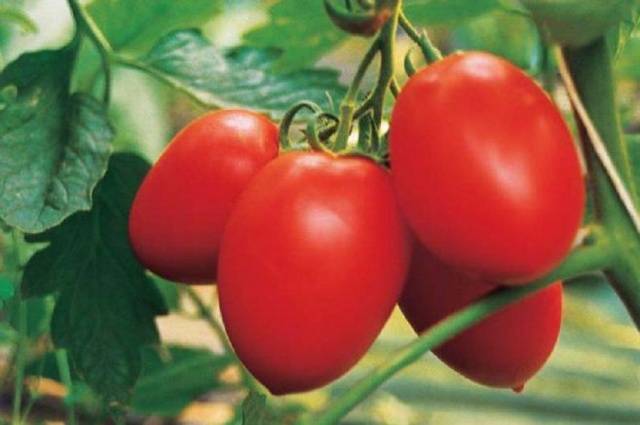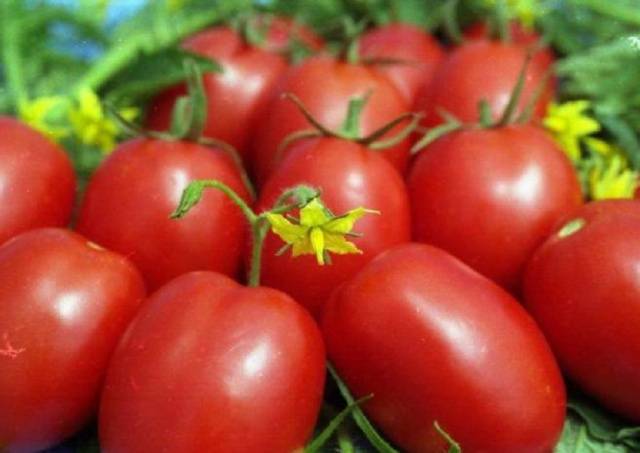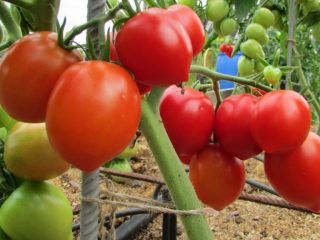Content
Breeders always develop new varieties of tomatoes taking into account the wishes of vegetable growers. Dutch experts offered farmers a wonderful variety with record yield, endurance and extraordinary taste. We are talking about the mid-season hybrid “Palenka”.
The Palenka tomato deserves attention due to its characteristics that meet the needs of even very demanding vegetable growers. This is confirmed by reviews from summer residents and photos of mature Palenka tomato bushes.
Main characteristics
The description of the Palenka tomato variety must indicate important characteristics. This is a list of the advantages and characteristics of tomatoes that vegetable growers should take into account when growing the variety. Basic information for summer residents is:
- Type of plant. The tomato is a first generation hybrid, therefore it is marked with the letter F1 on seed packets.
- Type of tomato bush. According to the description of the variety, the Palenka tomato belongs to indeterminate plants. This means that the bush of a plant with an endless growth process reaches a height of up to 2 meters. Therefore, the vegetable grower will need the ability to shape, tie and shoot tomatoes.
- Type of cultivation. The hybrid is recommended for cultivation in a greenhouse.Some hobbyists try to grow the plant in open ground, but in this case it is not possible to obtain all the qualities declared by the manufacturer.
- Harvest ripening period. Mid-early. After the seeds germinate, no more than 110 days pass until the fruits of the Palenka variety are fully ripe.
- Appearance and parameters of the Palenka tomato bush. The plant forms into one stem, which grows very powerful, there are no branches. Requires tying to a trellis. Carpal fruiting. The first cluster of tomatoes is formed after the 9th leaf; 5-6 tomatoes ripen in each cluster. The following tassels are tied regularly after 2-3 sheets.
- Fruit. Symmetrical glossy cream. The color of ripe Palenka tomatoes is bright red. The fruits have a rich taste and aroma. The weight of one tomato is 100-110 g. They tolerate transportation and storage well and do not crack when moved. Equally well suited for fresh consumption and preparations. They are used by housewives for canning whole fruits, making juices, purees and salads. It is highly valued by farmers for the quality of its fruit.
- Resistance to crop diseases. The hybrid tomato variety demonstrates good resistance to Verticillium and Fusarium wilt of roots, TMV, and cladosporiosis.
- Productivity is one of the most important characteristics of Palenque tomatoes. Many vegetable growers consider this indicator the most significant. With good care, 20 kg of high-quality fruits are harvested from one square meter of tomato planting area.
According to reviews from vegetable growers, the yield of the Palenka tomato variety covers all the hassle of growing the plant.
Advantages and disadvantages
Any vegetable crop has advantages and disadvantages.Their list can be compiled based on the reviews of those summer residents who have already grown the Palenka F1 tomato.
Advantages of tomato:
- unpretentiousness in any climate zone;
- evenness and uniformity of fruits;
- excellent taste;
- high and stable yield;
- excellent commercial quality;
- versatility of application;
- high indicators of keeping quality and transportability.
Summer residents also highlight some disadvantages of Palenka tomatoes:
- the need for pinching and formation of bushes;
- the need to install trellises and tie the stem;
- susceptibility to late blight;
- cultivation only in closed ground.
Those who have already grown indeterminate tomatoes in a greenhouse consider such parameters to be features of the agricultural technology of the Palenka variety. All the troubles are offset by the number of fruits. The yield of tall varieties of tomatoes is much higher than that of low-growing varieties. In addition, the yield of the harvest does not occur in 1-2 doses, but spread out over the entire season. According to reviews from farmers, the yield of the Palenka tomato in the greenhouse is very high, each bush is literally strewn with fruits (see photo).
Growing a hybrid - first steps
In order for tomatoes to begin to bear fruit earlier, the seedling method of cultivation is used. The technology for growing indent seedlings is almost no different from cultivating low-growing varieties. Sowing of Palenka tomato seeds is scheduled for mid-March so that the seedlings do not outgrow. If the planting material was purchased from a trusted supplier, then the licensed seeds have undergone pre-sowing treatment. In this case, the vegetable grower’s task is to take care of the quality of the substrate.
For tomato seedlings “Palenka F1”, a mixture of humus, turf soil and peat is prepared. The components are taken in equal quantities.Additionally, add 1 teaspoon of fertilizer to each bucket of the mixture:
- superphosphate;
- urea;
- potassium sulfate.
If the components are not prepared in advance, then buy ready-made soil mixture for seedlings. It has an optimal composition and sufficient nutrients.
Separately, it should be said about the choice of containers for indent seedlings. You can sow it in a box, and at the two-leaf stage, pick it out in separate cups. But it is better to take special cassettes in which the bottom extends. This will help transfer the seedlings into a larger container without damage. The container for seedlings of the tall Palenka tomato should be spacious so that the plants do not start growing in cramped conditions. Otherwise, the yield will decrease significantly.
The prepared container is filled with soil mixture and sowing begins. Tomato seeds of the “Palenka” variety are buried in the soil no more than 1.5 cm. Sprinkled with a thin layer of soil and covered with film.
Many vegetable growers are concerned about the ambient temperature values. According to the description of the Palenka tomato variety, the optimal temperature for:
- Seed germination is +23°C-+25°C. To maintain the value at a constant level, the planting containers are covered with film. As soon as shoots appear, the film must be removed.
- The first period of seedling growth remains within the same limits. After 2 weeks, reduce the indicator to 20°C. This is achieved by ventilating the seedlings.
- Disembarkation time is +18°C - +19°C.
Seedling care
The main points that a vegetable grower must carry out in a timely manner:
- watering;
- feeding;
- dive;
- ventilation;
- disease prevention.
Water the seedlings carefully and with warm water. According to the description of the properties of the variety, tomato seedlings “Palenka are moistened infrequently, but only after the top layer of soil has dried (see photo).
Plants dive in the two-leaf phase. Spacious containers are prepared in advance, filled with soil and seedlings with a lump of earth are transferred. In this case, the stem is buried down to the cotyledons.
Feeding is done according to the schedule. Seedlings need nutrition so that adult plants bear fruit better. The first time seedlings need feeding is a week after picking. Palenka tomatoes respond well to watering with an aqueous infusion of humus (10:1). After 7 days, water the seedlings with mineral fertilizers:
- urea – 0.5 tsp;
- superphosphate – 1 tbsp. l.;
- potassium sulfate – 1 tsp.
The substances are diluted in 5 liters of clean water and fed to tomato seedlings. It is more convenient to purchase ready-made complex fertilizer and dilute it according to the instructions.
2 weeks before planting, seedlings begin to harden to adapt the plants to the temperature inside the greenhouse. Seedlings of indeterminate varieties are ready for planting when they have 9 true leaves.
Planting in a permanent place and caring for plants
It is important for the gardener to adhere to the timing of planting the Palenka tomato in the greenhouse and the planting scheme. For closed ground, the planting density of tomatoes is no more than 3 bushes per 1 square meter. meter.
Advice from an experienced gardener on planting tomatoes in a greenhouse:
After a week, when the plants have taken root, the stems are tied to a vertical trellis with twine. Subsequently, every 3-4 days the main stem is braided around the twine.This technique prevents Palenka tomatoes from sliding down under the weight of the fruit.
The temperature in the greenhouse must be maintained. With sharp temperature fluctuations, tomato bushes of the Palenka variety can shed their ovaries. To prevent this from happening during the fruiting phase, the soil must be heated to 18°C, the air to 25°C during the day and 18°C at night.
It is also important to provide good lighting. Proper formation of the stem helps to avoid thickening of the bushes.
Useful video on this issue:
Another point that you need to pay attention to is the air humidity in the greenhouse. If waterlogging cannot be avoided, Palenka tomatoes may become susceptible to fungal diseases. Therefore, water the plants no more than 2 times a week, then loosen the soil and ventilate the room.
The leaves are torn only to the side. If you do this in a downward direction, you can injure the stem.
Fertilizing for the variety is carried out regularly, alternating every 2-3 weeks. Palenka tomatoes need the first feeding 2 weeks after planting in the greenhouse. For all fertilizing, complex mineral fertilizer is used. The consumption of the working solution is 0.5 l per area of 10 square meters. m.
Useful tips
For gardeners who are growing Palenka tomato varieties for the first time, it will be useful to remember the advice of professionals:
- For a hybrid, you must carefully follow the watering schedule. One miss, and the fruits crack and become smaller. During the period of active fruiting, the schedule does not change for indents. Therefore, watering is not reduced to ensure intensive fruit set.
- It is better to form plants into one stem.This ensures good illumination and ventilation of the Palenka variety bushes.
- It is necessary to root the plants. Otherwise, the uncontrolled growth of stepchildren will lead to the formation of a jungle in the greenhouse with all the ensuing consequences - diseases, reduced yields and weakened tomatoes.
- If the requirements of the variety's agricultural technology are not followed, the plants are susceptible to late blight.
- The formation and pinching of plants is done throughout the entire growing season.
Reviews
It is also useful to read the reviews and photos of farmers to make sure that the Palenka tomatoes correspond to the description of the variety.
















We planted palenka last year, after reading reviews I bought these seeds. The problems began at the stage of growing seedlings. Our tomato seedlings have never gotten sick, but the plant failed us. The yield was also not pleasing, the fruits were a bit harsh for my taste, only suitable for pickling. But, for pickling, I found another variety. Maybe I was unlucky with the seeds? I definitely won’t plant this variety again.